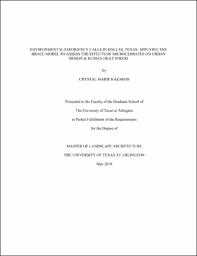
ATTENTION: The works hosted here are being migrated to a new repository that will consolidate resources, improve discoverability, and better show UTA's research impact on the global community. We will update authors as the migration progresses. Please see MavMatrix for more information.
Show simple item record
| dc.contributor.advisor | Jones-Allen, Diane | |
| dc.creator | Kazakos, Crystal Marie | |
| dc.date.accessioned | 2019-05-28T21:10:00Z | |
| dc.date.available | 2019-05-28T21:10:00Z | |
| dc.date.created | 2019-05 | |
| dc.date.issued | 2019-05-13 | |
| dc.date.submitted | May 2019 | |
| dc.identifier.uri | http://hdl.handle.net/10106/28111 | |
| dc.description.abstract | The objective of the study is to investigate how the practice of landscape architecture can help mitigate the effects of climate change and the urban heat island effect on vulnerable block groups in Dallas, Texas by using a model framework, to assess, project, analyze, develop, and evaluate microclimates in these urban areas.
This study investigated how the physical morphology of urban areas affect the frequency of heat-related environmental emergency calls by applying the Center for Disease Control’s (CDC) Building Resilience Against Climate Effects (BRACE) framework. Geographic Information Systems (GIS) was used to identify warm trends in Dallas block groups in relation to urban morphology, demographic vulnerability and the location of heat-related environmental emergency calls. This process will examine if any connections to impacts can be drawn where the practice of landscape architecture may help to mitigate or improve. Mapping this data gives practitioners the ability to identify and assess heat stress vulnerability to prevent disease burden by implementing lacking landscape features such as tree canopy, vegetation, shade structures, or other means of cooling the urban landscape. The BRACE model provides the framework for assessing, projecting, analyzing, and evaluating microclimates in these urban areas.
Through the use of this framework, several vulnerable areas have been identified, which includes a thorough analysis of three focus areas of Dallas, where bioclimatic interventions are suggested that can be implemented by landscape architects (LA’s), planners, architects, city officials and future policy can ideally significantly impact the health of Dallas residents.
Applying the BRACE model is a fundamental step for any region of the world to assess and visualize the potential impacts of future climate change. This model utilizes quantitative data, accessible by many researchers, such as, weather, health, and demographic data. This data offers the ability for planners and designers a lens to focus on areas that may possess critical factors that require further interventions in respect to public health and well-being of individuals in vulnerable localities. The effects of climate change are significant around the world and require more attention. Therefore, the responsibility of entities whose job is to develop safe living spaces for people should take priority and require an acknowledgment that there are ways in which thoughtful design and development can adapt to a warming environment.
| |
| dc.format.mimetype | application/pdf | |
| dc.language.iso | en_US | |
| dc.subject | Dallas | |
| dc.subject | Texas | |
| dc.subject | Heat stress | |
| dc.subject | Impervious surfaces | |
| dc.subject | Microclimates | |
| dc.subject | Landscape architecture | |
| dc.subject | BRACE model | |
| dc.subject | Environmental emergencies | |
| dc.subject | Tree canopy | |
| dc.subject | Vulnerable populations | |
| dc.title | Environmental Emergency Calls in Dallas, Texas: Applying the BRACE Model to Assess the Effects of Microclimates on Urban Design & Human Heat Stress | |
| dc.type | Thesis | |
| dc.degree.department | Landscape Architecture | |
| dc.degree.name | Master of Landscape Architecture | |
| dc.date.updated | 2019-05-28T21:10:00Z | |
| thesis.degree.department | Landscape Architecture | |
| thesis.degree.grantor | The University of Texas at Arlington | |
| thesis.degree.level | Masters | |
| thesis.degree.name | Master of Landscape Architecture | |
| dc.type.material | text | |
| dc.creator.orcid | 0000-0002-3588-856X | |
Files in this item
- Name:
- KAZAKOS-THESIS-2019.pdf
- Size:
- 15.21Mb
- Format:
- PDF
This item appears in the following Collection(s)
Show simple item record


